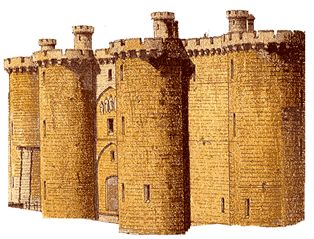|
The Bastille was big. Very big. It left a whole bunch of rubble, and other remains. So where'd they go?
"Patriot" Payot, who directed the demolition of the castle, famously had models of the Bastille carved out of a number of the stones and sent them as gifts to different departments of France. Some survive, including at least one in the Carnavalet Musuem, though many in local museums today are reproductions. He also used other parts of the castle in these models. The one sent to the (then) Department of Mont-Blanc, for instance, was on a stand made from wood taken from a draw-bridge. Piles of 'cannon balls' were made from balls of shot from the Bastille. And he made a number of other objects from materials in the castle, as well.
Still, this accounts for only a small part of a very large structure. Where else did scattered bits or objects from it end up? At least some of it was used around Paris - the municipality paid the state over 40,000 pounds reimbursement for the materials. Here, in Paris and elsewhere, are some places to look:
Tradition has it that the Pont de la Concorde (started in 1787) was finished with stones from the Bastille. Apparently, this tradition is unsupported by exact documentation. But that's certainly one place to check, the next time you cross it (which you probably will, if you find yourself in Paris.) In 1899, the foundations of one of the towers - the Tower of Freedom (Liberté) - were found near the Place de la Bastille and moved to the Galli Square, where you can still see them:


(Anthony's Web Page has another modern shot of these, as well as further items about the Bastille.)
The square is at the beginning of the Boulevard Henri IV, across from the end of the Isle Saint-Louis that is farthest from the Ile de la Cité.
A bit of the parapet outside the main castle can be seen on the quay of the Ligne 5 of the Parisian subway, at the Bastille station. 
The weapons which had been kept in the gate house were probably dispersed during the attack on the castle (though one source said they had been removed that morning.) However, one 19th century magazine said some of the artillery pieces could then be seen at the Museum of Artillery, which, in 1905 was combined with the Historic Museum of the Army to create the Museum of the Army (at Invalides). So some pieces from that collection might be found there. More specifically, the Museum of Artillery in Draguingan, near Marseille, calls itself the 'heir' to that collection and seems to have pieces from it. The clock - or at least the carillon - from the Bastille seems to be in the Centre-Musée Européen d'Art Campanaire in L'isle-Jourdain. Unfortunately, the one image shown here doesn't include its face, described in several works on the Bastille. The Canal St. Martin corresponds to the part of the old moat (ditch) that fed into the one around the castle.
Some other pieces survived in the years following the Bastille's fall, though it's not clear where they are now:
In November 1789, Payot and his workers used material from the Bastille to build platforms for cannons on the terrace of the Pont-Neuf. These may or may not have been converted to other uses, or otherwise have survived subsequent renovations. Apparently, at the start of the 19th century, a few sculpted flames remained from the Bastille, on a terrace touching what had been the governor's wall at No 8 of the Rue de La Cerisaie. Several houses still standing in the nineteenth century had been built with stones from the Bastille: When the Rue Jean-Jacques Rousseau was first renamed (from Rue de la Plàtrière), the street signs were made from Bastille stones. However, these had already been replaced with the standard enamel signs by the end of the nineteenth century. A painting from the Bastille chapel showing St. Peter in Chains was taken to the Hotel de Ville the day after the Bastille's fall. The Hotel de Ville itself was burned in 1871, so if the painting was still there it was probably destroyed.
|


 or mug:
or mug: ?
? 
